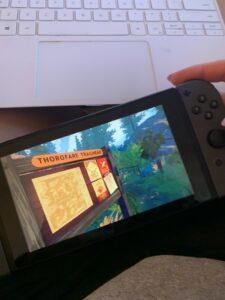Firewatch is made by Campo Santo, and it is a first-person single-player mystery game. I played it on my friend’s Nintendo Switch, but it’s also available on Linux, OS X, PlayStation 4, Windows, and Xbox One. Campo Santo describes it as “a mystery set in the Wyoming wilderness, where your only emotional lifeline is the person on the other end of a handheld radio”. While it is primarily a walking sim in terms of mechanics, it is a mystery game at its core with its narrative. The gameplay is focused on character development and exploration while the plot includes a series of mysterious events that Henry, the main character you play as, encounters while on his job. These mysteries drive the story forward, engaging the player in trying to uncover what is really happening in the seemingly tranquil wilderness. The unfolding mystery, combined with the game’s isolated setting, contributes to a tense and intriguing atmosphere that keeps players engaged – I honestly kept waiting for jumpscares even though there aren’t any. Overall, in Firewatch, the integration of its interactive dialogue mechanics and a carefully designed detailed natural setting with exploration not only advances the plot but also deepens the player’s emotional engagement, demonstrating how even narrative-driven video games can use interactive capabilities to help users gradually “unlock” a mystery story. In addition, Firewatch’s mystery elements appeal to not just one of Richard Bartle’s taxonomy of player types, making the narrative applicable to a wide variety of players.
Firstly regarding mechanics, central to Firewatch is the radio communication between Henry and his supervisor, Delilah. This mechanic is important for progressing the story and also allows for emotional depth through player choice in dialogue. This might appeal to Socializers who value interaction and relationship-building in games. Choosing responses impacts the emotional outcomes of conversations, drawing players into the psychological complexity of the characters’ interactions, making the mystery weightier.
 Walking in the game
Walking in the game
Moreover, a major game mechanic is the fact that you are walking primarily to progress the game forward, along with some interactions with objects. The game’s emphasis on exploration caters to Explorers, as they are likely to like discovering hidden locations and subtle story elements – namely, clues to the underlying mystery – embedded in the environment. The exploration is rewarding not just geographically but narratively, as uncovering new areas or items is what triggers new dialogue or plot developments, deepening the mystery and the player’s engagement.
The setting of Firewatch and how the players interact with it is key to the game’s unfolding. The isolated Wyoming wilderness is more than just a backdrop; it’s an active narrative device that controls the pacing and unfolding of the plot. The design of the area, with paths that lead to new discoveries and others that circle back to familiar places, creates a physical narrative loop that helps funnel along the game’s story arcs. In addition, this setting manipulation ensures that players, especially Explorers and Achievers, find satisfaction in traversing the environment to “unlock” all the secrets and game progress. Moreover, the use of physical and temporal barriers (like locked areas that only open if you acquire some object or events that happen at certain times) I found to be helpful for me going through the narrative, as it maintained suspense and intrigue for figuring out Henry and others’ backstories and kept me motivated to keep playing to find out more info.
 Example of the dialogue mechanic
Example of the dialogue mechanic
The dialogue options and choices Firewatch provided me allowed me to feel actively like I contributed to the personality and responses of Henry. This level of agency helped me feel more immersed in the unfolding mystery and an active player in the narrative. By choosing how Henry reacts to certain events or what he discloses to Delilah, I could steer conversations in directions that revelaed/obscured information. This choice-driven dialogue fosters a deeper connection to the narrative, as I felt directly responsible for some of the outcomes.
With regards to loops – the day-to-day activities that I performed through Henry established a routine that made disruptions more impactful. This design reflected the real-life monotony of some jobs but also made any deviation feels significant and mysterious, and any specific new dialogue feel important. These loops helped maintain a narrative rhythm that engaged me as I am inclined towards routine and stability, and might also appeal to Socializers who enjoy the depth of ongoing relationships and routines in gameplay. Furthermore, the overarching arc of Henry’s summer, coupled with smaller mystery arcs like the missing girls as well as Ned and Brian’s story created a layered and real narrative experience. This structure likely attracts Explorers and Achievers, as Explorers are drawn to the unfolding story and the environmental storytelling, while Achievers would probably find the resolution of these arcs in the end of the game satisfying as they contribute to a sense of completion and accomplishment, knowing that all the loose ends are tied up (girls were safe, etc).



